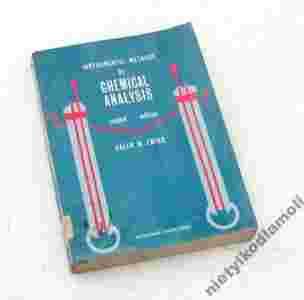|
Instrumental Methods of Chemical Analysis
GALEN W. EWING
McGRAW-HILL BOOK COMPANY, INC. 1960 str. 454, stan db (podniszczona lekko okładka, nieaktualne pieczatki i syg.)
Preface
The principal changes in the second edition, aside from general updating, are the following: (1) A revision in the sequence of topics intended to facilitate the teaching of instrumental analysis concurrently with physical chemistry. (2) The inclusion of material on magnetic resonance spectroscopy, gas chromatography, and electrochromatography. (3) The addition of a chapter on electronic circuitry, designed to fill a long-felt need in the training of chemists.
The general objective, as in the first edition, is to describe the important modern analytical methods with sufficient theory for their comprehension and to present significant design features of representative apparatus. Emphasis is placed on the possibilities and limitations inherent in the various methods.
The text is planned for use in upper-level undergraduate or first-year graduate classes. It is not intended to compete with those excellent compilations of analytical techniques which are addressed to the research analyst. To be taught most effectively, this course should follow a course in classical quantitative analysis and at least one year of physics. It may be presented following or concurrently with physical chemistry.
No claim is made that the subjects presented cover the whole of instrumental analysis. There are additional methods which might have been included but which were ruled out for one reason or another. The elements of distillation analysis, for example, are generally covered adequately in the laboratory work in organic chemistry. On the other hand, microwave absorption exemplifies a technique which may turn out to be of great importance in analysis but which as yet has not acquired such stature.
Mention of the products of individual manufacturers does not necessarily imply that the author considers them superior to competing items. The aim is to describe instruments typical of their class or possessing some special features of interest, not to write a complete catalogue of analytical apparatus.
The experiments included are for the most part those which have proved successful in the student laboratory under the author's direction. Instructions for the operation of specific makes or models of instruments are not included because of the diversity to be expected in different laboratories.
Contents
Preface
PART ONE. PRINCIPLES
1. Introduction
2. Introduction to Optical Methods
3. The Absorption of Radiation: Ultraviolet and Visible
4. The Absorption of Radiation: Infrared
5. Emission Spectroscopy
6. Analytical Aspects of X-rays and Electron Beams
7. Polarimetry
8. Refractivity and Dispersion
9. Introduction to Electrochemical Methods
10. Potentiometry
11. Voltammetry and Polarography
12. Electrodeposition and Coulometry
13. Conductimetry
14. Radioactivity as an Analytical Tool
15. Mass Spectrometry
16. Magnetic Resonance Spectroscopy
17. Extraction Analysis
18. Chromatography
19. Ion Exchange
20. Thermometric Methods
21. General Considerations in Analysis
22. Electronic Circuitry for Analytical Instruments.
PART TWO. LABORATORY EXPERIMENTS
Introduction
1. Absorptiometry: Comparison of Methods
2. Absorptiometry: Nickel by Dimethylglyoxime
3. Absorptiometry: Chromium and Manganese in Steel
4. Absorptiometry: Identification of a Complex
5. Absorptiometry: Ultraviolet Spectrum of an Organic Compound
6. Absorptiometry: Analysis of APC Tablets
7. Absorptiometry: Study of an Indicator
8. Absorptiometry: Infrared Analysis of Xylene
9. Turbidimetry: Sulfate by Barium Chloride
10. Fluorimetry: Aluminum in a Zinc Alloy; Electrolysis at Mercury Cathode
11. Emission Spectrography: Qualitative Analysis
12. Emission Spectrography: Quantitative Analysis
13. Flame Photometry: Water Analysis
14. Polarimetry and Refractometry: Determination of Sucrose
15. Potentiometric Titration: Neutralization
16. Potentiometric Titration: Iodometric Redox Reaction
17. Potentiometric Titration: Determination of Iron by Cerate
18. Polarography: Study of Apparatus and Methods of Plotting
19. Polarography: Analysis of Cadmium-Zinc Solutions
20. Amperometric Titration: Lead by Dichromate
21. Conductometric Titration: Solubility of Silver Sulfate
22. Controlled-potential Electrodeposition
23. Coulometric Titration: Arsenite by Bromine
24. Gas Chromatography
25. Thermometric Titrations
26. Photoelectric Photometers
Appendix
Name Index
Subject Index
Zapraszam na inne moje aukcje
|
|

